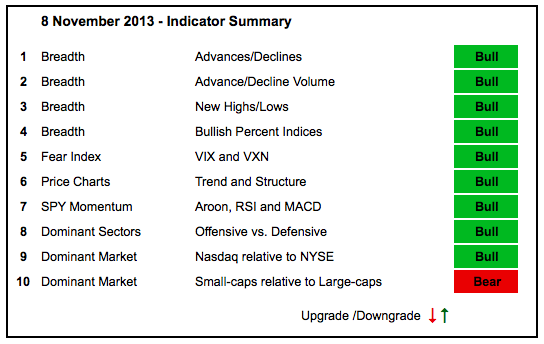The bulk of the evidence remains bullish, but this uptrend is getting long in tooth and the market is ripe for a correction. Note that the majority of technical indicators have been positive for a year now, which is the longest stretch since I began this table. Even though the market is ripe for a correction, timing such a correction is a bigger challenge. Relative weakness in small-caps is the only negative right now. The Nasdaq does not show relative weakness yet, but the price relative ($COMPQ:$NYA ratio) flatted the last five weeks. Also note that the Finance SPDR (XLF) shows relative weakness.
- AD Lines: Bullish. The Nasdaq AD Line hit a new high in mid October and pulled back sharply the last two weeks. The NYSE AD Line hit a new high in late October and pulled back, but the pullback was not as sharp. Both remain in long-term uptrends.
- AD Volume Lines: Bullish. The Nasdaq AD Volume Line stalled the last six weeks, but remains above the October low, which marks key support. The NYSE AD Volume Line pulled back, but remains with a series of rising peaks and rising troughs.
- Net New Highs: Bullish. Net New Highs on both the Nasdaq and the NYSE remain positive and support the long-term uptrend in the stock market.
- Bullish Percent Indices: Bullish. All nine sector Bullish Percent Indices are above 50%.
- VIX/VXN: Bullish. The S&P 500 Volatility Index ($VIX) and the Nasdaq 100 Volatility Index ($VXN) fell back to the low end of their 2013 range in mid October and bounced on Thursday.
- Trend-Structure: Bullish. The five major index ETFs hit new highs in October and remain in long-term uptrends(DIA, SPY, MDY, IWM and QQQ).
- SPY Momentum: Bullish. RSI bounced off the 40-50 zone and MACD (5,35,5) turned up near the zero line in early October. The Aroon Oscillator turned up and moved above +50 in late October.
- Offensive Sector Performance: Bullish. XLY, XLK and XLI hit new highs this week, but the XLF fell well short and shows relative weakness. Three of the four are still holding up well.
- Nasdaq Performance: Bullish. The $COMPQ:$NYA ratio stalled the last five weeks, but has yet to actually break down and reverse the uptrend that started in April.
- Small-cap Performance: Bearish. The $RUT:$OEX ratio formed a lower high in mid October and broke support with a sharp decline. Small-caps are underperforming and this is negative.
- Breadth charts (here) and intermarket charts (here) have been updated.
This table is designed to offer an objective look at current market conditions. It does not aim to pick tops or bottoms. Instead, it seeks to identify noticeable shifts in buying and selling pressure.
This commentary and charts-of-interest are designed to stimulate thinking. This analysis is
not a recommendation to buy, sell, hold or sell short any security (stock ETF or otherwise).
We all need to think for ourselves when it comes to trading our own accounts. First, it is
the only way to really learn. Second, we are the only ones responsible for our decisions.
Think of these charts as food for further analysis. Before making a trade, it is important
to have a plan. Plan the trade and trade the plan. Among other things, this includes setting
a trigger level, a target area and a stop-loss level. It is also important to plan for three
possible price movements: advance, decline or sideways. Have a plan for all three scenarios
BEFORE making the trade. Consider possible holding times. And finally, look at overall market
conditions and sector/industry performance.

